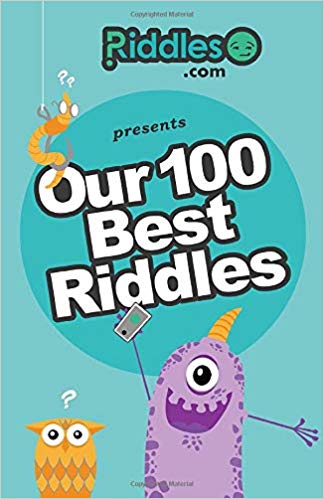Enter a keyword into the search box. The riddle search will check to see if the word is in the Title, Riddle, or Answer and return results if they exist.
"Math" Riddles - Next 10 of 41.
Riddle:
I am a place, in a state. I am an answer to a math problem. The math problem is: To get a cube, you multiply something by 6. What do you multiply by?
Answer: You Times Square!
Riddle:
So, you're a math wiz. You know 2 nickles is 20 cents. How much is 1000 Canadian pennies?
Answer: Nothing, in Canada pennies are worthless.
Riddle:
Man gave one son 10 cents and another son was given 15 cents. What time is it?
Answer: 1:45. The man gave away a total of 25 cents. He divided it between two people. Therefore, he gave a quarter to two.
Riddle:
A man called 911 and said he saw a masked man, the police said where are you? They said 3325 Quader Street, when the police went there, they never came back. Why?
Answer: The man who called is the masked man.
Riddle:
You're stranded in a rainforest, and you've eaten a poisonous mushroom. To save your life, you need an antidote excreted by a certain species of frog. Unfortunately, only the female frog produces the antidote. The male and female look identical, but the male frog has a distinctive croak. Derek Abbott shows how to use conditional probability to make sure you lick the right frog and get out alive. How do you get out alive?
Answer: If you chose to go to the clearing, you're right, but the hard part is correctly calculating your odds. There are two common incorrect ways of solving this problem. Wrong answer number one: Assuming there's a roughly equal number of males and females, the probability of any one frog being either sex is one in two, which is 0.5, or 50%. And since all frogs are independent of each other, the chance of any one of them being female should still be 50% each time you choose. This logic actually is correct for the tree stump, but not for the clearing. Wrong answer two: First, you saw two frogs in the clearing. Now you've learned that at least one of them is male, but what are the chances that both are? If the probability of each individual frog being male is 0.5, then multiplying the two together will give you 0.25, which is one in four, or 25%. So, you have a 75% chance of getting at least one female and receiving the antidote. So here's the right answer. Going for the clearing gives you a two in three chance of survival, or about 67%. If you're wondering how this could possibly be right, it's because of something called conditional probability. Let's see how it unfolds. When we first see the two frogs, there are several possible combinations of male and female. If we write out the full list, we have what mathematicians call the sample space, and as we can see, out of the four possible combinations, only one has two males. So why was the answer of 75% wrong? Because the croak gives us additional information. As soon as we know that one of the frogs is male, that tells us there can't be a pair of females, which means we can eliminate that possibility from the sample space, leaving us with three possible combinations. Of them, one still has two males, giving us our two in three, or 67% chance of getting a female. This is how conditional probability works. You start off with a large sample space that includes every possibility. But every additional piece of information allows you to eliminate possibilities, shrinking the sample space and increasing the probability of getting a particular combination. The point is that information affects probability. And conditional probability isn't just the stuff of abstract mathematical games. It pops up in the real world, as well. Computers and other devices use conditional probability to detect likely errors in the strings of 1's and 0's that all our data consists of. And in many of our own life decisions, we use information gained from past experience and our surroundings to narrow down our choices to the best options so that maybe next time, we can avoid eating that poisonous mushroom in the first place.
Riddle:
School starts at 8:30, they do math at that time, they do reading at 9:00, they do music at 9:30, they do P.E. at 10:00, then more math at 10:30, then they have tests at 11:00 then correcting them at 11:30 then Lunch at 12:00 and recess at 12:30, then they do reading at 1:00, then they do small group stations at 1:30 then they do another recess at 2:00 then they have a party at 2:30 and then they clean up after the party at 3:00, what time do they go home today?
Answer: 3:30 because each activity is 30 minutes so they clean up for 30 minutes then leave at 3:30!
Riddle:
A man bumps into his mathematician friend on the street whom he hasn't seen in 5 years. The man asks the mathematician how old his children are. The mathematician, who always replies in riddles said, "I now have three children. The sum of their ages is equal to the number of windows on the building in front of you and the product of their ages equals 36." The friend then says "I need one more piece of information." The mathematician then replies "My youngest child has blue eyes." What are the ages of the mathematician's three children?
Answer: They are 6, 6, and 1.
Riddle:
1. Trigonometry, Geometry, Cirrus, Calculus
2. Comic book, Atlas, Novel, Brain teasers book
3. Otter, Shark, Dolphin, Sea Lion
4. Pen, Pencil, Eraser, Chalk
5. Golden Delicious, Bartlett, Granny Smith, Jonathon
Which one does not belong to each line?
Answer: 1. Cirrus because the others are all mathematics
2. Atlas because the others are all for leisure/pleasure reading
3. Shark because the others are all marine mammals
4. Chalk because the others are all desk tools
5. Bartlett because the others are types of apples
Riddle:
What single-digit number should go in the box with the question?
| 6 | 5 | 9 | 2 | 7 |
| 1 | 4 | 3 | 5 | ? |
| 8 | 0 | 2 | 8 | 1 |
Answer: The missing number is 4. Simply add the first and second rows together to get the third row value.
| 65, 927 | |
| + | 14, 354 |
| 80, 281 |
Riddle:
When the celebrated German mathematician Karl Friedrich Gauss (1777-1855) was nine he was asked to add all the integers from 1 through 100. He quickly added 1 to 100, 2 to 99, and so on for 50 pairs of numbers each adding to 101.
Answer: 50 X 101=5,050.
What is the sum of all the digits in integers from 1 through 1,000,000,000? (That's all the digits in all the numbers, not all the numbers themselves.)
Answer: The numbers can be grouped by pairs:
999,999,999 and 0;
999,999,998 and 1'
999,999,997 and 2;
and so on....
There are half a billion pairs, and the sum of the digits in each pair is 81. The digits in the unpaired number, 1,000,000,000, add to 1. Then:
(500,000,000 X 81) + 1= 40,500,000,001.

